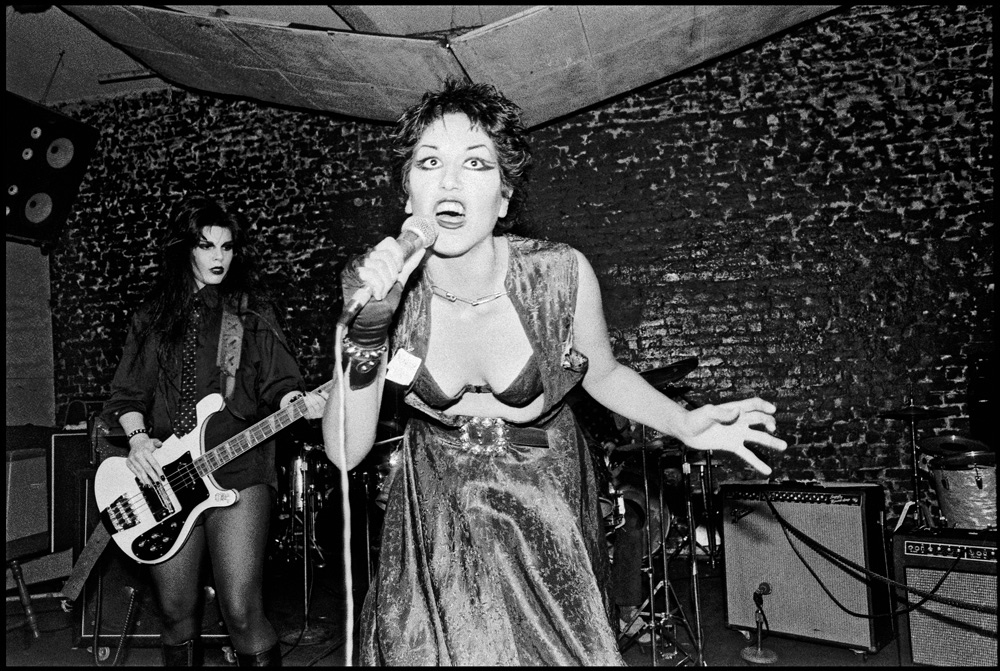A visual history of San Francisco’s industrial scene
- Text by Miss Rosen
- Photography by Ruby Ray

While working at Tower Records in San Francisco during the summer of 1977, Ruby Ray spotted V. Vale, a mysterious figure she had seen walking through North Beach. He was dressed in leather, long scarves, and carrying a stack of magazines under his arm.
“I was working at the cash register and I told the guy, ‘Look I have to leave right now!’” Ray remembers. “I ran after Vale and asked him what he had, and he showed me the magazine, Search & Destroy. I asked, ‘Don’t you need more photos?’ and he said, ‘Yeah, do you know any photographers?” I said, ‘Yes, me!’ That’s how it all started.”
From that fated encounter, a historic collaboration was born, one that unfolds masterfully in the new book, Ruby Ray: Kalifornia Kool, Photographs 1976-1982 (Trapart Books).

Booji Boy Finds Pretty Pictures, 1977. Mark Mothersbaugh, in his alter ego as Booji Boy, shops at the Wharf.

Z’EV was Cooked, 1979. Z’ev, industrial shaman using swinging oil drums, was cooked for Rhythm & Noise Live Spectacle.
Whether she was documenting the Mutants playing a show for the inmates at Napa State Mental Hospital in 1978, or going backstage at the Mabuhay to photograph Sid Vicious after he tried to upstage the Bags by going on stage and cutting himself with broken glass, Ray captures the gritty glamour of SF punk as it hit the world stage.
As an insider, Ray saw it all, on stage and off. Her photographs of the Cramps, Devo, Darby Crash, Alice Bag, Exene Cervenka, Bruce Conner, William S. Burroughs and Cosey Fanni Tutti evoke the sensation of pure consciousness, of living in and for the moment. For her first shoot, she spent the day with the Dills, before heading to their gig later that night. “They totally blew me away,” she says. “I was so excited I couldn’t contain myself.”

Bruce and Jean, 1979. Artist and Filmmaker Bruce Conner with his artist/wife Jean Conner under a cobweb in their yard.

The Bags, 1978. Alice Bag sings and snarls. Pat Bag later played in the Gun Club and the Damned.
“My boyfriend at the time wasn’t into punk rock, so he wasn’t my boyfriend that long. But when he picked me up after the show was over, I got into the backseat of the car and I vomited because I had been dancing so crazy — it’s like I had to purge my past by puking it up.”
Her boyfriend, like many others, was not thrilled: “People hated [punks] and were constantly mocking us. They didn’t write about us in the paper. We were forming our own subculture because no one cared about us.”
“San Francisco is a small city, so a lot of cross currents were happening. It was a competitive period. Everyone was trying to be more artistic or a better band or wilder clothes – everyone was doing something to contribute to the punk ethos.”

Slits – She Bit the Apple, 1981. Viv Albertine and Ari Up, on tour with the Slits from London, connect with the mythic on the RE/Search roof.

Nam Nico on the Razor’s Edge, 1979. Former Velvets’ Chanteuse at the Mabuhay with her epithet “She runs through the world like an open razor, and one might get cut.”

Ruby Ray: Kalifornia Kool, Photographs 1976-1982 (Trapart Books) launches on March 28 at City Lights Bookstore, San Francisco.
Follow Miss Rosen on Twitter.
Enjoyed this article? Like Huck on Facebook or follow us on Twitter.
You might like

As Kneecap and Bob Vylan face outcry, who really deserves to see justice?
Street Justice — Standing in for regular newsletter columnist Emma Garland, Huck’s Hard Feelings host Rob Kazandjian reflects on splatters of strange catharsis in sport and culture, while urging that the bigger picture remains at the forefront of people’s minds.
Written by: Robert Kazandjian

Alex Kazemi’s Y2K period novel reminds us that the manosphere is nothing new
New Millennium Boyz — Replete with MTV and endless band t-shirt references, the book follows three teenage boys living in 1999 USA as they descend into a pit of darkness. We spoke to its author about masculinity, the accelerated aging of teenagers, and the rebirth of subcultures in the algorithm age.
Written by: Isaac Muk

In photos: The people of Glastonbury’s queer heart The NYC Downlow
Elation and family — Once a year, a meatpacking warehouse nightclub springs up in Glastonbury’s South East corner and becomes a site of pilgrimage for the festival’s LGBTQ+ scene. We met the people who make The NYC Downlow so special.
Written by: Isaac Muk

“Moment of escape”: Maen Hammad’s defiant West Bank skate photos
Landing — Choosing to return to Palestine after growing up in the USA, the photographer found himself drawn to Ramallah’s burgeoning skate scene. His debut monograph explores the city’s rebellious youth, who pull tricks in the face of occupation.
Written by: Miss Rosen

Inside the weird world of audio porn
Porn without pictures — Storyline-driven and ethical, imageless erotica exploded during the pandemic. Jess Thomson speaks to the creators behind the microphones.
Written by: Jess Thomson

We are all Mia Khalifa
How humour, therapy and community help Huck's latest cover star control her narrative.
Written by: Alya Mooro

